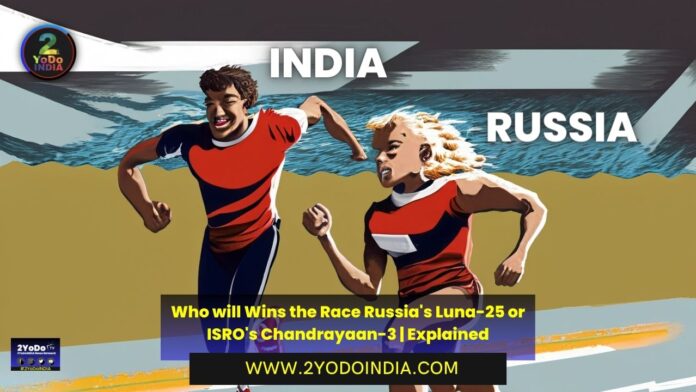Indian Space Research Organisation (ISRO) patiently completes its one-month journey to the moon, a Russian spacecraft has already lock its eyes on the lunar surface. The Luna-25 craft is set to attempt a moon landing near its south pole around 23rd August 2023, the same time as Chandrayaan-3 landing.
Launch into space almost four weeks after ISRO’s mission, the Russian lander and rover is expect to quickly land itself in the lunar orbit of 100 kms by 16th August 2023.
It could target a landing on the south pole of the moon by 21st-23rd August 2023.
There is a chance that it may land on the moon before Chandryaan-3.
But besides the landing feat, both the missions are design differently with varying objectives.
But what has perplexed many is how the Russian rocket could traverse 3.84 lakh km distance to the moon in just six to seven days, outpacing ISRO which took a month to do so.
Because, unlike the global space powers Russia, China and the US, India does not plan a direct journey to the moon.
Instead, it goes in phases, which lasts for up to 40 days.
How Chandrayaan-3 Reaches Moon?
ISRO lifts off its rocket from Sriharikota which parks the spacecraft into an elliptical orbit around the earth.
The spacecraft keeps revolving around the earth as scientists at ISTRAC, Bengaluru conduct a series of manoeuvres to gradually raise its orbit step by step.
ISRO conduct as many as five such manoeuvres starting from 15th July 2023.
Finally, when the spacecraft reach an orbit of 1,27,603 X 236 km, it was propelled towards the moon on 1st August 2023 through a translunar orbit.
It was gradually capture by the moon’s sphere of influence and successfully inject into the lunar orbit on 5th August 2023.
ISRO is in the process of gradually reducing this elliptical orbit until it settles into the desire polar orbit of the moon over the lunar pole.
The next manoeuvre is line up for 14th August 2023.
If everything goes as per plan, then on 23rd August 2023,
ISRO will perform a series of complex braking manoeuvres to attempt a soft landing in the south polar region.
But Russia’s rocket will directly reach the trans-lunar orbit to reach the moon quicker than Chandrayaan-3.
Why Chandrayaan-3 takes this much Time?
The main reason is that other space faring nations have powerful rockets which can carry huge amounts of fuel into space and have advance engines.
Whether its Russia’s Soyuz rockets, China’s Long March series, or the US’s Saturn V or Delta IV heavy, or SpaceX’s Falcon series, they are all some of the world’s most powerful rockets.
The US-led Apollo missions complete their journey to the moon within a week in 1960s.
China went to the moon in December, 2020 aboard its Long March rocket (Changzheng 5 (CZ-5) and return within 24 days carrying lunar samples.
Russia is using its powerful Soyuz 2.1 for its latest moon mission that comes almost after 47 years since the last lunar mission, and will reach the moon within six to seven days.
When these rockets lift off, they can give the necessary thrust to the spacecraft to directly reach for the moon, instead of waiting in the earth orbit.
ISRO’s most powerful and reliable rocket, the LVM-3 (GSLV MK3) has far less fuel capacity and thrust.
It also cannot carry payloads beyond a certain weight limit, which restricts its ability to conduct quicker inter-planetary missions.
While it is adequate for most earth-bound satellite missions, the inter-planetary missions require more thrust.
But ISRO has trying to turn this limitation into an opportunity by pitching its space missions as more cost-effective.
Can Russia wins the Race?
Russia’s lunar spacecraft is expect to park itself in the lunar orbit of 100 kms by 16th August 2023, and target a landing on the south pole of the moon by 21st-23rd August 2023.
There is a chance that it may land on the moon before Chandrayaan-3 attempts the touchdown on 23rd August 2023.
As Russia has attempt the feat many times before, it will be India’s first.
Besides a successful demonstration of landing, both the missions are design differently with different research objectives.
As of July, 2023, there are six active lunar orbiters, one of which is occupied by Chandrayaan-2 orbiter launch in 2019.





